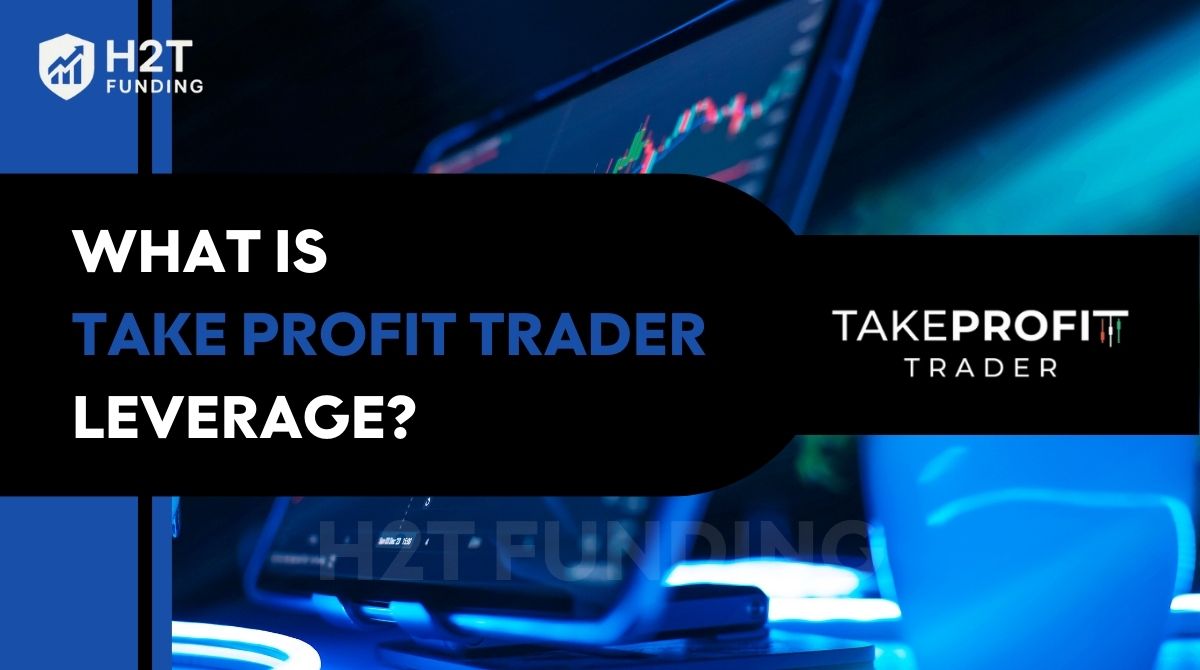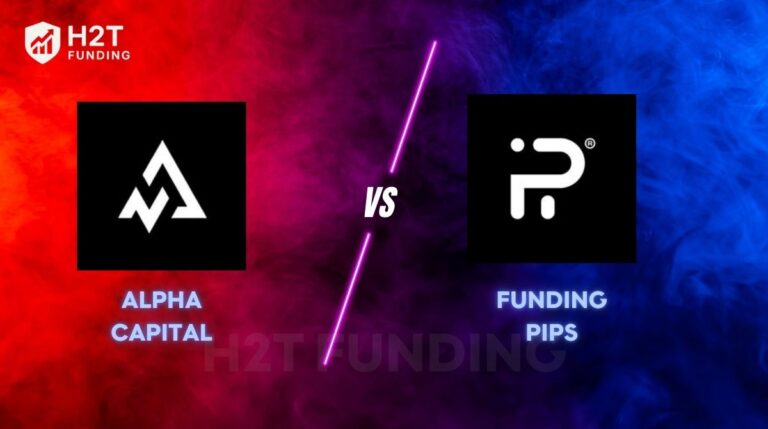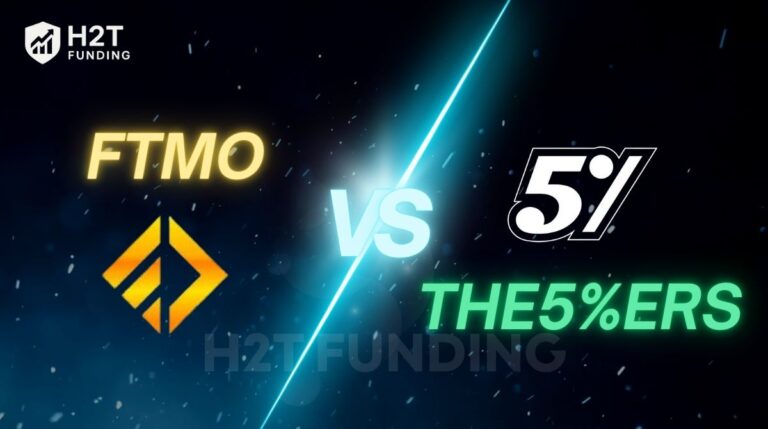When I first typed What is Take Profit Trader leverage into the search bar, I was honestly expecting a huge number, just like in forex, where traders often rely on leverage without a clear trading plan. What I found instead was a futures prop firm with a completely different approach to leverage, and it genuinely forced me to rethink my entire trading plan.
If you’re new, don’t worry. I’ll keep it simple, clear, and practical. I’ll show you how Take Profit Trader handles buying power, why 1:1 matters, and how contract limits shape risk so you don’t get blindsided mid-trade.
Key takeaways:
- Take Profit Trader is a futures prop firm founded in 2021 in Orlando, Florida.
- The firm offers five account sizes ranging from $25k to $150k, with monthly fees from $150 to $360.
- Leverage at Take Profit Trader is fixed at 1:1, so the account balance equals buying power.
- Trading limits are defined by the maximum number of contracts per account size.
- Profit split starts at 80/20 and increases to 90/10 at the PRO+ stage.
- Rules include a 6% profit target, at least 5 trading days, and restrictions on trading during major news.
- Traders can choose from 15+ platforms with CQG and Rithmic data feeds.
- No leverage means safer risk control but slower growth, ideal for disciplined futures traders.
1. Introduction to Take Profit Trader
Take Profit Trader, often called TPT, is not just another name in the prop firm space. Founded in 2021 and based in Orlando, Florida, this firm was built with a clear mission: to fund futures traders who are ready to prove their skills without risking their own savings.
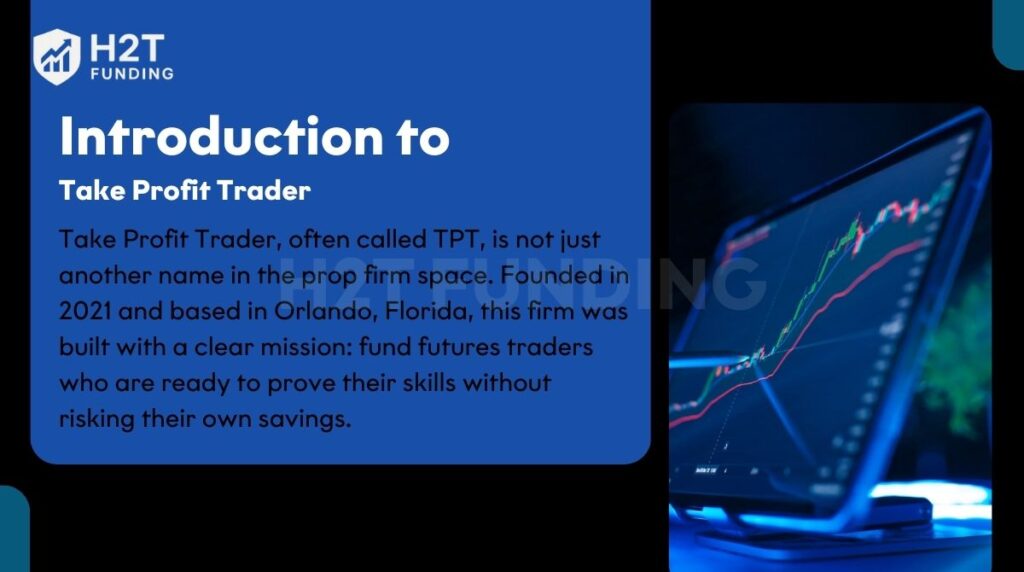
I remember when I first came across TPT; what struck me was how quickly they moved compared to other firms. Instead of waiting weeks or months, traders could secure funding in just a few days.
One feature that really stands out is the single-step evaluation. Many prop firms stretch this into two or more phases, but TPT keeps it straightforward. You hit the profit target, respect the rules, and you’re funded. That simplicity takes away a lot of stress, especially if you’ve been through long evaluations elsewhere.
The payout structure also feels rewarding. At the PRO level, traders take home 80% of profits, and if you reach PRO+, that share jumps to 90%. From my perspective, this is more than just a number; it’s motivation. Knowing that almost all of what you earn goes back into your pocket changes how you approach each trade.
As for what you can trade, the list is broad: equity futures, forex futures, energy contracts, bonds, metals, and agricultural markets. For someone like me who prefers diversity in my setups, that flexibility is a real edge. You’re not boxed into one type of market; you can shift focus depending on volatility and opportunity.
In short, TPT sets itself apart with its speed, fairness in payouts, and variety of futures instruments. For traders who are tired of drawn-out evaluations and limited choices, understanding how prop firms make money can also provide context for why TPT’s model feels like a breath of fresh air.
2. What is Take Profit Trader leverage?
At Take Profit Trader, leverage works very differently from what most forex traders expect. The official leverage is 1:1, which means there is no artificial boost to your buying power. If you hold a $50,000 account, that $50,000 is exactly the capital you can work with. The balance itself becomes your trading power, closely tied to every price level and the support and resistance you choose to enter.
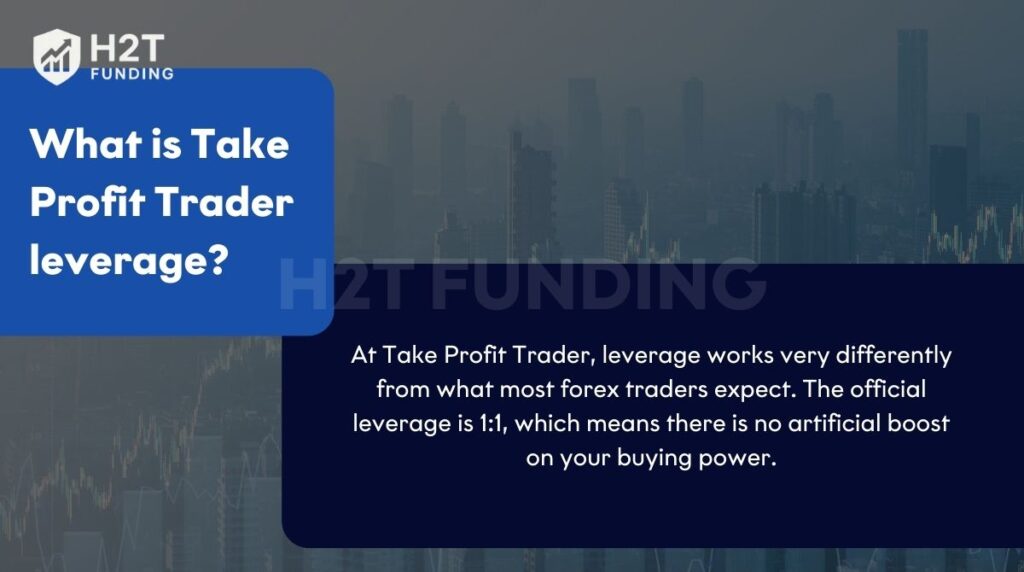
When I first discovered this, it felt strange. Coming from a forex background where firms often offer 1:50 or even 1:100, I was used to seeing exaggerated numbers that made it easy to open oversized positions.
At TPT, you don’t get that luxury, and at first, I thought it was a disadvantage. But then I realized something: removing high leverage forces you to respect every single trade. It creates a discipline that many beginners, including myself when I started, tend to ignore.
The benefit here is clear. Without leverage, your account is safer from sudden wipeouts caused by a single oversized position, reducing the chance of hitting a severe drawdown in trading.
The risk, however, is also real; you can’t stretch your capital as aggressively. That means slower growth, but in return, you gain steadiness that reflects real market price action. Personally, I would trade steadiness over a wild ride any day, because consistency is what keeps you in the game.
In short, Take Profit Trader’s leverage being 1:1 means your balance equals your power, no shortcuts. It might feel limiting at first, but for futures traders who value discipline, it becomes an advantage that protects your account.
3. Why TPT chooses the 1:1 leverage model
There’s a reason why Take Profit Trader stands firm on the 1:1 leverage model. Futures markets already carry significant volatility, and piling on high leverage would only invite reckless behavior.
By removing leverage, TPT encourages traders to focus on precision, risk management, and avoiding the opportunity cost of reckless short-term trading decisions. This model reminds traders that slow growth is not wasted time, but a smart way to reduce the opportunity cost of chasing unrealistic profits.
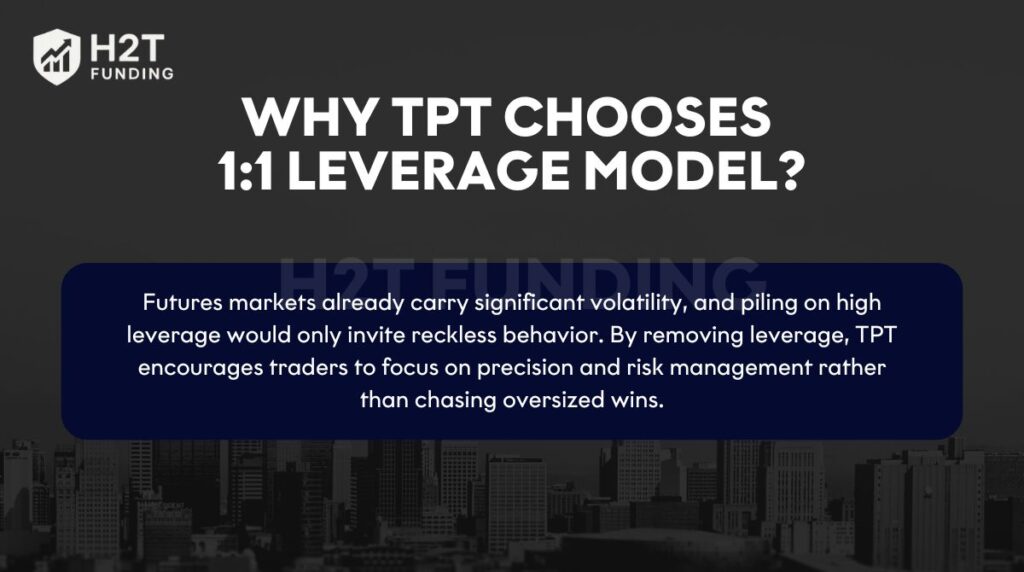
From my experience, this approach makes sense. Early in my journey, I blew accounts because I leaned too heavily on leverage, treating it like free money. At TPT, that temptation doesn’t exist. Every contract feels meaningful because you know it’s directly tied to your account balance. It changes the way you see risk and reward.
For professional futures traders, this setup is actually liberating. You’re no longer trying to game the system with leverage; instead, you focus on strategy, execution, and discipline. That’s why many who succeed at TPT end up building habits that last far beyond the firm’s walls.
So, don’t look at the 1:1 leverage model as a limitation. I see it more as a smart filter that sifts out undisciplined trading and keeps those who genuinely prioritize risk control. For me, that’s the kind of clean environment a trader needs to build a sustainable career.
4. Maximum contracts allowed per account size
Since leverage is fixed at 1:1, Take Profit Trader sets limits based on contracts instead of margin multipliers. Each account size comes with a maximum number of mini or micro contracts you can trade at once.
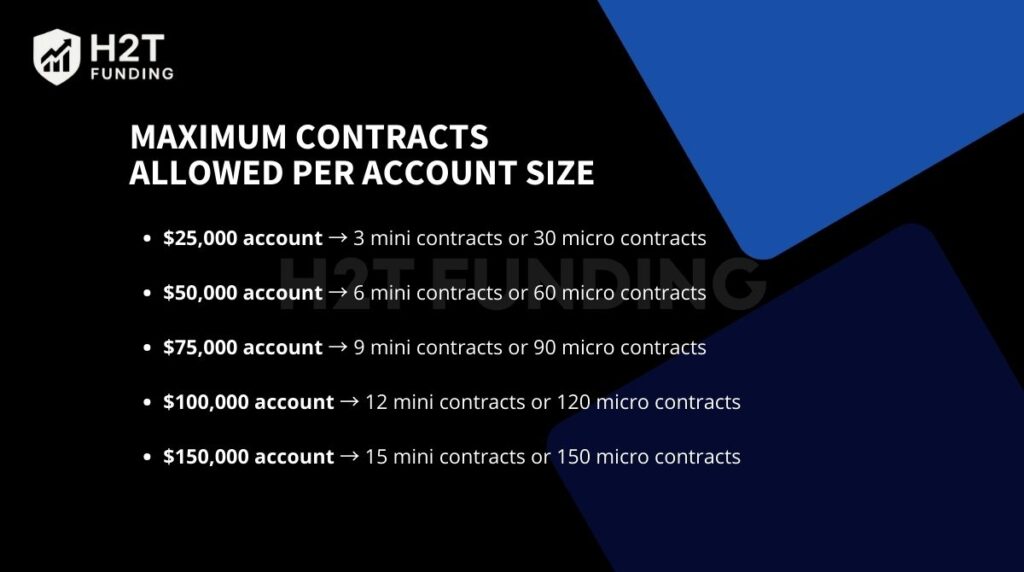
Here’s the breakdown:
- $25,000 account → 3 mini contracts or 30 micro contracts
- $50,000 account → 6 mini contracts or 60 micro contracts
- $75,000 account → 9 mini contracts or 90 micro contracts
- $100,000 account → 12 mini contracts or 120 micro contracts
- $150,000 account → 15 mini contracts or 150 micro contracts
I remember testing the waters with a $50,000 account. Knowing I could only take six mini contracts at most gave me a clear ceiling. It stopped me from over-committing in volatile sessions, something I had struggled with before.
These limits are not random; they are designed to keep traders from blowing up accounts while still giving enough flexibility to capture real opportunities at each price level. If you’re coming from a forex background, understanding lot size can help you see the similarity between position sizing in forex and contract limits in futures.
To sum it up, contract limits at TPT define your true leverage. Instead of chasing exaggerated ratios, you work within realistic boundaries that make you a more consistent trader, focusing on trading systems that adapt to different price movements.
5. Other key features of Take Profit Trader
When traders look at a prop firm, the fine details often decide whether it’s worth joining. Take Profit Trader has a handful of features that stand out, and I’ve seen both the strengths and challenges of these rules while testing their model myself.
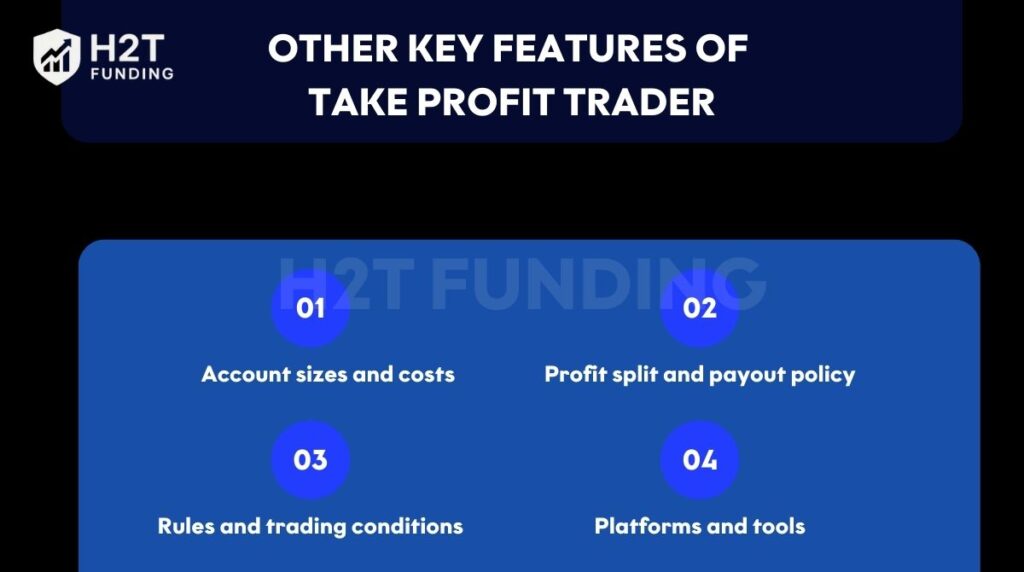
5.1. Account sizes and costs
Take Profit Trader offers five account sizes: $25,000, $50,000, $75,000, $100,000, and $150,000. Monthly fees start at $150 for the smallest account and reach $360 for the largest.
I remember hesitating between the $25,000 and $50,000 accounts. The lower cost felt safer for testing the waters, but the bigger account offered more breathing room with contracts. That choice carries real weight because the fee comes out of your pocket every month until you pass.
For new traders, this can feel like pressure, but in a way, it keeps you accountable. You treat every trade as if it matters because you’ve already invested in the seat.
Costs are straightforward, and the range gives both cautious beginners and experienced traders an entry point.
5.2. Profit split and payout policy
At the PRO level, you keep 80% of your profits. Once you reach PRO+, that split climbs to 90%. Payouts can start as soon as your account goes live, which is rare in the industry.
Honestly, that moment I realized I could request a payout on day one of being funded was a game-changer. Most other firms make you wait weeks, if not months. Getting rewarded for your effort immediately, like this, does more than just build trust; it’s a clear signal that the firm is serious and actually respects your work.
The payout structure is simple and generous, with fast access to earnings that motivate traders to stay consistent. For traders preparing for their evaluation, learning how to pass a prop firm challenge can be a valuable step before reaching the PRO or PRO+ levels.
5.3. Rules and trading conditions
TPT’s evaluation has a profit target of 6% and a minimum of five trading days. There’s no maximum time limit, which relieves the stress of racing against a clock, unlike some prop firms with the lowest minimum trading days that push traders into rushing their setups.
The removal of the daily loss limit in 2025 was a welcome change. I remember celebrating that update because it made the rules far more forgiving.
Still, the trailing drawdown can be tricky. In my early attempts, I hit profits but lost the account when the market pulled back before the day ended. That experience taught me the importance of placing a proper stop-loss order to protect gains instead of relying on hope. That sting taught me to lock in gains rather than let hope manage the trade.
News restrictions also add pressure: positions must be closed before major releases like FOMC or NFP. For someone who likes volatility, waiting those few minutes can feel like forever.
The rules are clear but strict, rewarding discipline while punishing carelessness.
5.4. Platforms and tools
One of TPT’s biggest strengths is platform variety. You can trade on over 15 options, including NinjaTrader, TradingView, Tradovate, Jigsaw Daytradr, and R Trader Pro, which makes it easier for beginners still searching for the best trading strategy for beginners to test different styles comfortably. Data feeds include CQG and Rithmic, both of which are reliable for fast execution.
Platform flexibility gives traders the freedom to work with what they know, reducing the friction of starting fresh with a funded account.
Read more of our articles:
6. FAQs about Take Profit Trader leverage
No. The leverage is fixed at 1:1, so your balance equals your trading power.
It’s based on your account balance and the maximum contracts allowed for that account size.
No. Even with micros, you are capped by the contract limits tied to your account size.
Not really. TPT only funds futures trading, so forex-only traders may find it limiting.
The firm wants to keep risk under control and push traders to rely on skill, not oversized leverage.
7. Conclusion
So, what is Take Profit Trader leverage? Take Profit Trader keeps leverage at 1:1, meaning there’s no artificial boost on buying power. Instead of using margin like in forex prop firms, you work within strict contract limits that scale with your account size.
This difference might feel limiting at first, but it creates a safer environment for futures traders who want discipline and long-term growth. It allows them to build a strategy that goes beyond day-to-day wins. In many ways, it’s similar to personal finance, where life improves once you stop living paycheck to paycheck and follow strict rules and structure.
By focusing on contracts instead of leverage, TPT pushes you to build strategies that survive real market pressure. If you’re genuinely in this for the long haul as a futures trader, this model will naturally instill a deep respect for risk. It also forces you to sharpen your skills. The path is not easy, but it’s a rewarding one.
For more deep dives and comparisons on other prop firms, feel free to check out the guides over at H2T Funding in the Prop Firm & Trading Strategies section.

